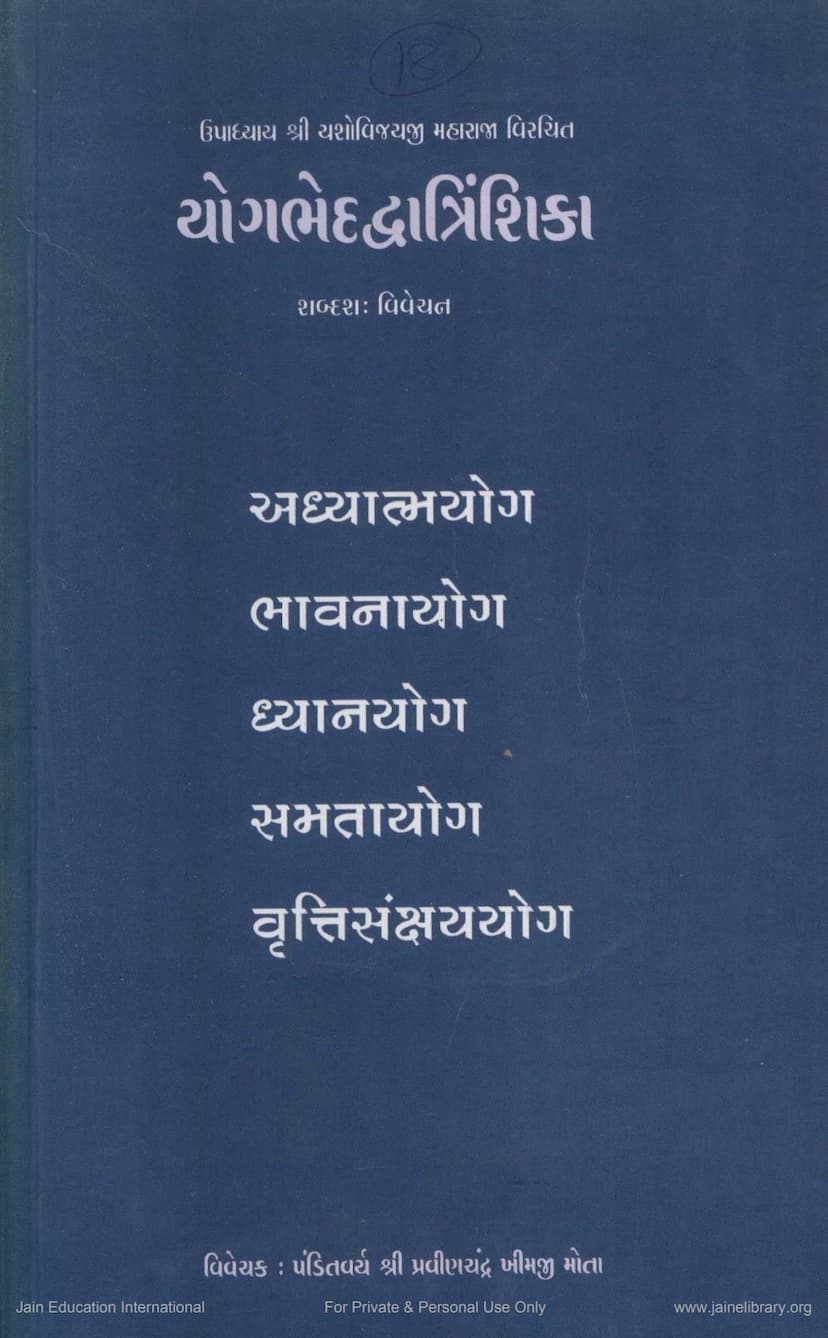Yogabheda Dvantrinshika
Added to library: September 2, 2025

Summary
The book "Yogabheda Dwātrinśikā" (Yogabheda Dwātriṃśikā), authored by Upadhyaya Shri Yashovijayji Maharaj and critically analyzed by Panditvar Shri Pravinchandra Khimji Mota, is a profound exploration of various yogic paths as understood within the Jain philosophical tradition. Published by Gitarth Ganga, this work delves into the subtle distinctions and practices of different forms of Yoga.
Here's a comprehensive summary based on the provided text:
Core Concept: Yoga as the Union with the Soul for Moksha
The book defines Yoga as the "activity of the soul that connects it with Moksha (liberation)." It emphasizes that true Yoga is an internal pursuit aimed at spiritual realization and the cessation of the cycle of birth and death.
Classification of Yoga: The Fivefold Path
The central theme of the book is the classification of Yoga into five distinct types, elaborated upon by Mahāmahopādhyāya Shri Yashovijayji Maharaj:
-
Adhyātmayoga (Spiritual Yoga): This is presented as Yoga rooted in contemplation of the true nature of the soul. It involves adhering to righteous conduct (vratas) and engaging in righteous thinking, aligning one's internal state with the teachings of the Jinas. It is characterized by righteous conduct achieved through appropriate practices and the contemplation of reality, imbued with virtues like friendliness.
-
Bhāvanāyoga (Meditative Cultivation Yoga): This form of Yoga focuses on cultivating specific internal states or contemplations that lead to spiritual growth. The text details five crucial Bhavanas (contemplations) that foster steadfastness and spiritual progress:
- Jnānabhāvanā (Contemplation of Knowledge): Understanding the nature of what is to be known.
- Darśanabhāvanā (Contemplation of Right Faith): Perceiving reality as it is.
- Caritravāvanā (Contemplation of Right Conduct): Engaging in virtuous conduct and self-discipline.
- Tapobhāvanā (Contemplation of Austerity): Engaging in practices that lead to the shedding of karmas.
- Vairāgyabhāvanā (Contemplation of Detachment): Cultivating detachment from worldly pleasures and objects.
-
Dhyānayoga (Concentration Yoga): This Yoga involves focused concentration on a single object or principle. The text highlights the importance of purifying the mind by renouncing eight obstacles or defects (doshas) that hinder concentration. These defects include:
- Kheda (Dejection)
- Udvēga (Agitation)
- Bhrama (Delusion/Confusion)
- Utthāna (Restlessness/Instability)
- Kṣēpa (Distraction/Transference)
- Āsaṅga (Attachment/Clinging)
- Anyamudrā (Focusing on something other than the primary object)
- Ru'gu (Physical or mental ailment/blemish) The text explains that overcoming these obstacles is crucial for achieving steadfast and profound meditation, which leads to self-mastery and the cessation of karmic bondage.
-
Samatāyoga (Equanimity Yoga): This Yoga emphasizes the attainment of equanimity and mental balance amidst dualities like pleasure and pain, gain and loss. It describes how, through discernment and the contemplation of reality, one develops an equal attitude towards desirable and undesirable objects, free from attachment and aversion. Equanimity is seen as a state of profound inner stillness that contributes to the reduction of subtle karmas.
-
Vr̥ttisaṅkṣayayoga (Yoga of Cessation of Mental Modifications): This is the ultimate stage of Yoga, involving the complete cessation of mental activities, both volitional (vikalpa) and involuntary (parispanda). This state leads to the attainment of Kevalajñāna (Omniscience), the Śailēśī state (the final stage of karmic elimination), and ultimately, Moksha.
Key Themes and Concepts:
- The Importance of Scripture: The book stresses the necessity of adhering to the teachings of the liberated souls (Jinas) and the scriptural injunctions (āgama) as the guiding principles for yogic practice.
- The Interplay of Yoga and Conduct: The text illustrates how various yogic practices are intrinsically linked to ethical conduct (gupti – restraint, samiti – careful conduct) and the cultivation of virtuous states of mind.
- The Role of Bhavanas (Contemplations): The book extensively details the four Bhavanas – Maitrī (friendliness), Karuṇā (compassion), Muditā (sympathetic joy), and Upekṣā (equanimity) – and their significance in spiritual progress, particularly in paving the way for Adhyātmayoga.
- The Four Levels of Bhavanas: Within each of the four Bhavanas, there are sub-classifications based on the object of contemplation (e.g., helpful, one's own, accepted, all-encompassing), highlighting the progressive nature of spiritual development.
- The Impact of Defects: The detailed explanation of the eight defects hindering meditation underscores the practical challenges faced by practitioners and the importance of overcoming them.
- The Interdependence of Yoga and Equanimity: The text emphasizes that Dhyāna (meditation) and Samatā (equanimity) are mutually reinforcing, with each supporting the progression of the other.
- The Goal of Liberation: The ultimate aim of all these yogic practices is to achieve Moksha, characterized by eternal bliss, omniscience, and freedom from the cycle of rebirth.
- The Role of the Commentator: Panditvar Shri Pravinchandra Khimji Mota's commentary (vivechan) provides a detailed, verse-by-verse explanation of the original text, making the profound concepts accessible to the reader.
In essence, "Yogabheda Dwātrinśikā" serves as a guide for aspirants seeking to understand and practice different dimensions of Yoga within the Jain framework. It systematically breaks down the path to spiritual liberation, emphasizing the importance of scriptural guidance, mental discipline, ethical conduct, and progressive internal cultivation.